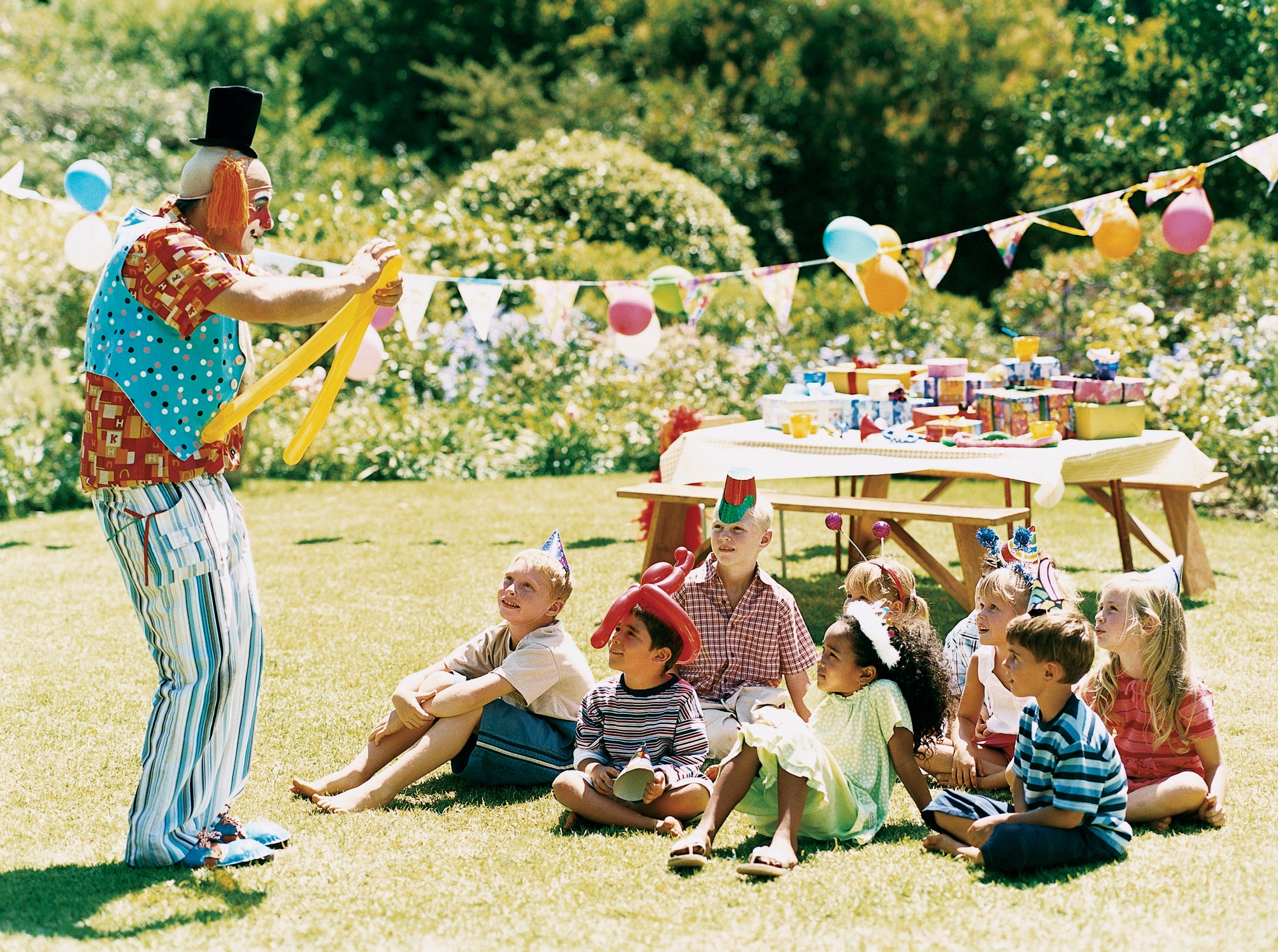-
How to Throw a Children’s Birthday Party on a Budget

Children’s birthday parties are a beloved part of childhood, a time honored tradition, and with good reason. It’s natural to want to celebrate your little one, marking every milestone, and birthdays are a natural cause for celebration. These days, however, it’s easy to let a birthday party get out of hand. Whether you get carried away with the excitement of celebrating your child or you’re trying to keep up with the Joneses, before you know it, your budget is out the window. It doesn’t have to be that way, though. We have some great tips for throwing an amazing birthday party while sticking to your budget.
- Don’t feel pressured to throw a party every year. When kids are little, birthdays mean more to the parents than they do to the children. Consider taking your little one on a fun outing, rather than spending money on a party that won’t even be remembered. You might also think about having a birthday party every other year, and doing something special with a friend or the family on the alternate years.
- Keep parties small and intimate. You do not have to invite the whole class or even the whole soccer team to your child’s birthday party. It’s much more manageable to keep the guest list under 10 children. In fact, one good rule of thumb is to invite one child for every year of age. For a five year old birthday party, five kids is plenty.
- Be smart about timing. Don’t plan your parties for mealtime, when you’ll have to put out a whole spread. Instead, choose a time in between meals, when some simple snacks and a birthday cake or cupcakes will suffice.
- Make as much as possible yourself. Make your own invitations, either by hand, if you’re crafty, or digitally, if you’re not. There are plenty of cute invitations online, and it won’t cost you anything to send them via email. You can make your own cake or cupcakes, too, and if you want a themed cake, head to a cake decorating store and pick up some cheap decorations to stick on it. Putting together your own snacks and making your own decorations can also cut down on costs.
- Take advantage of available resources. Check out books or a DVD from the library to entertain the kids. Find some printables online that you can print out for free as a fun activity or decoration. Use things you already own to support your party theme. (Hint: pick a theme for which you know you already have supplies!) Borrow equipment if you want to do something special, like a backyard movie.
- Shop early for the best deals. Sites like Oriental Trading Company have great deals on party favors and décor, but you can’t order at the last minute. Plan ahead a little bit, and you will be surprised how much money you can save.
- Pick a party location that’s free. Your house is a great example, but if you don’t feel like your house is suitable for hosting, take some time to think about other free options. It might be a park, the beach, your subdivision’s pool, or a neighbor’s house, but you’re likely to find somewhere that will work perfectly. If not, look into cheap options like the local rec center.
- Provide an activity that doubles as a favor. Let kids do a craft or decorate cookies or cupcakes, then take those treasures home. This is cheaper than filling a goody bag, and the parents will thank you when there are not so many plastic trinkets floating around their houses.
- Choose classic games for simple fun. Old school games like musical chairs, hot potato, four square, duck duck goose, or red rover are big hits with young kids, and they don’t cost a thing. Not quite sure of the rules? Look for game instructions online.
At the Center for Vasectomy Reversal, we love watching people enjoy their families. We pride ourselves on helping men improve their fertility through uncompromising, concierge-level patient care. Under the direction of Dr. Joshua Green, our team provides state-of-the-art treatment for men who need a reversal of their vasectomy or have other fertility concerns. To learn more, contact us through our website or call 941-894-6428.
-
How to Teach Your Kids About Sun Safety

Parents have many important jobs, and one of them is to teach children about safety. We educate our kids on everything from eating healthy foods to safely crossing the street to protecting themselves from stranger danger. With all you need to teach your children about the dangers of the world, has sun safety made it into your lesson plan yet? It really should be one of the first things you teach, because protecting them from the sun early in life and teaching them to do it for themselves will go a long way in helping to keep their skin healthy for the rest of their lives. Here are some helpful tips for teaching your kids about sun safety.
- Teach them about the tools they’ll need for sun protection. It starts with sunscreen, of course, but sun protection goes further than that. Sun protective clothes and hats can provide help, and sunglasses can protect from the damage UV rays can do to the eyes. Teach kids to seek out natural shade or sit under an umbrella to help reduce their sun exposure.
- Explain how to apply sunscreen. Because it doesn’t work as well when it’s not properly applied, make sure your kids know that sunscreen needs to be slathered on, and buy products that are easy for them to apply, even without your help. Teach that wet or sweat means re-apply, and that sunscreen should be re-applied every two hours, even when they aren’t swimming.
- Talk about timing. Sun protection is great, but kids also need to know that UV rays are at their strongest between 10 am and 4pm. One way to make this concept come alive for kids is to play the shadow game. Have them look for their shadows, and explain that if they’re short, that means the sun is higher and stronger. Whenever they have short shadows, they should find a shady spot in which to play. The longer their shadows become, the more they can expand their play area.
- Give them reasons not to tan. As kids get older, your kids may become interested in tanning. According to a study by the American Academy of Dermatology, 63 percent of teenagers think they look better with a tan, 59 percent believe that people look healthier when they are tan, 43 percent of teenagers lie out in the sun to get a tan, 28 percent of female teens and 14 percent of male teens say they do not use sun block. Only 30 percent of teens say they use sun block when they lie out in the sun. Teach your kids that tanning is a sign of skin damage, and tanning beds are especially hazardous. If they insist, buy some tanning lotion so that they can safely tan their skin.
- Set a good example. If you want kids to wear sun screen every single day, they need to see you wearing sunscreen every single day. Modeling proper sun protection is the best way to teach your children that sun protection is important.
- Make sun protection fun. Let your little ones choose their own hats, sun glasses, and sun protective clothing, in fun patterns that will make them want to wear these items. You can also make sunray-sensitive jewelry together, stringing ultraviolet detection beads onto a piece of leather. Tie this around your child’s wrist or ankle, and explain that when the beads change color, it’s time to put on sunscreen. Sing a song like “head, shoulders, knees, and toes” as you apply sunscreen, talking about the areas of the body that people need a little help reaching, and which ones need the most sunscreen.
At the Center for Vasectomy Reversal, we love making the world better by helping people grow their families. We pride ourselves on helping men improve their fertility through uncompromising, concierge-level patient care. Under the direction of Dr. Joshua Green, our team provides state-of-the-art treatment for men who need a reversal of their vasectomy or have other fertility concerns. To learn more, contact us through our website or call 941-894-6428.
-
Old Wives’ Tales About Childcare

There is knowledge in parenting that has been passed down through the generations. Some of this is good advice, sound, common sensical wisdom handed down from grandmother to mother to child and treasured as a gift. Some of it, however, is nonsense. Let’s talk about some things your grandmother may have passed along that are not quite right. Which as much scientific knowledge as we have in the modern era, there’s no need to cling to old wives’ tales about childcare.
- Many myths persist on the topics of standing and walking. For instance, many people believe that wearing shoes will help babies learn to walk sooner, when going barefoot is actually better. Soft-soled shoes that look like moccasins are wonderful for babies learning to walk, because they are flexible and help the baby feel the ground. Children who are walking need comfortable, flexible shoes. Another walking myth is that babies learn to walk sooner when they use a walker. Actually, baby walkers slow down a child’s progression into sitting, crawling, and walking, and are, in fact, dangerous. The American Academy of Pediatrics has even suggested a ban on walkers. A better alternative is an exersaucer.
- Let’s look at some myths about the mouth. It is commonly thought that thumb sucking causes buck teeth, but that is, in reality, not the case. Thumb sucking is natural, and often begins before birth. As long as children stop sucking their thumbs by about age four, it should not cause a problem. Thumb sucking over age five can cause buck teeth, but peer pressure usually discourages this behavior. Another common myth is that teething can cause a child to run a fever, or have diaper rash, a fever, or a runny nose. Other problems attributed to teething include sleep issues and lowered resistance to infection, but teething does not really cause any of these things. When a teething baby has some of these other symptoms, it usually indicates a virus; babies who are teething are also building immunity at the same stage.
- Myths about milestones can make new parents nervous. No, you don’t need to worry that something is wrong with a baby who gets teeth late, and feeding babies solid food early won’t help them sleep through the night. Babies who are late talkers do not necessarily have autism, and babies who are nervous about strangers when they are four to six months old are not insecure and unloved, they are going through a perfectly normal stage of development.
- We know more about environmental concerns than we did when most of these myths were started. Some people worry that taking a picture of a baby using flash photography is dangerous, but that is not true. There is also an old wives’ tale that air conditioning is bad for a baby, and another that says cats are dangerous to infants because they will steal the baby’s breath. Think about some of these concerns logically, and you will see there’s no need to worry.
- There are far too many myths about medical care. Let’s get the weirdest one out of the way first: people used to think blowing smoke into a baby’s ear would cure an ear infection by warming the ear canal. As we now know, second hand smoke raises a baby’s risk of respiratory infections and ear infections. That’s far from the only myth about taking care of a sick baby, though. Many grandparents still believe that you should treat a fever by plunging a child into a cold bath to lower the temperature or piling on blankets to “sweat the fever out.” Neither of these are good ideas, and both could actually exacerbate the illness. Treat a child’s fever with acetaminophen or ibuprofen, and see a doctor if it goes above 100.5°F in a very young baby or 104°F in an older child. Another myth is that wounds should be allowed to “air out,” but it is recommended to cover a cut or scrape to prevent exposure to contaminants. Never put butter or ice on a burn, but put the affected area under cool water to bring down the temperature and numb the area. Similarly, don’t put alcohol on a teething baby’s gums, but relieve teething pain with teething gel, teething toys, or a cool washcloth. One final old wives’ tale: that you should tilt a child’s head back if he or she is experiencing a nosebleed. A more effective option is to tilt the head forward while pinching the soft part of a child’s nose, below the bridge. This will allow blood to flow out of the nose instead of into the throat, and the nose-pinching will eventually stop the flow of blood.
At the Center for Vasectomy Reversal, we love making the world better by helping people grow their families and offering good advice to new parents. We pride ourselves on helping men improve their fertility through uncompromising, concierge-level patient care. Under the direction of Dr. Joshua Green, our team provides state-of-the-art treatment for men who need a reversal of their vasectomy or have other fertility concerns. To learn more, contact us through our website or call 941-894-6428.
-
How to Transition Your Toddler to Their Own Room

There are so many milestones in a toddler’s life, and the transition out of mom and dad’s room is a big one. Whether you have been co-sleeping or just had the crib in your room, and whether you are about to have a new baby or you just feel it’s time to reclaim your adult space, it can be upsetting to your child. After all, your little one has shared this space with you since birth! Your toddler may not make this big change easily, but there are some things you can do to help smooth the way.
- Take your time. If you are expecting a new baby, make sure to begin the transition long before the new little one’s arrival. That way, you can make the move gradual, for less drama. You never want your older child to feel supplanted or replaced by a younger sibling, because that can create lasting resentment. Begin the process by bringing some of your child’s most treasured belongings into the new room, like toys and stuffed animals. Play together in the new room, making it a place with positive associations, and incorporate the room into your bedtime routine, perhaps reading a bedtime story in that room.
- Make it a big deal. You want your child to feel excited about the move to the “big kid room.” Talk it up, getting excited about how much space there is for playing in that room, and start decorating it especially for your toddler. Give your child some control over the décor, allowing involvement in picking out the colors, the sheets, etc. Of course, you don’t need to hand over the reins to your opinionated little one, but do things like offering choices between two different colors or patterns. This gives the child a sense of control and makes the change feel less intimidating.
- Keep things the same as much as possible. For instance, if your child is not yet ready to leave the crib, move it into the new room rather than trying to change rooms and beds at the same time. Don’t change things like bedtime, and leave the bedtime routine as similar to the old routine as possible. When your toddler knows what to expect, the adjustment will be easier to manage.
- Fade yourself out of the picture. There is a technique called fading that is very useful in getting a child to sleep solo or in his or her own room. The first night, the parent sits on the bed with the child until the child falls asleep. The next night, the parent moves further away, perhaps into a chair beside the bed, leaving after the child falls asleep. Each night, the parent moves a little bit further away, until, finally, once the bedtime routine ends, the parent leaves the room. If the child wakes up in the middle of the night, the parent should return to wherever he or she was when the child fell asleep until the child goes back to sleep.
- Make it a party! What toddler doesn’t love a good party? Once your child has transitioned to the new room, throw a celebration to build excitement, perhaps getting your child a small surprise gift, like a new nightlight or lovey. Point out all the new and special things about the room, expressing excitement about what a cool big kid room it is.
At the Center for Vasectomy Reversal, we love making the world better by helping people grow their families. We pride ourselves on helping men improve their fertility through uncompromising, concierge-level patient care. Under the direction of Dr. Joshua Green, our team provides state-of-the-art treatment for men who need a reversal of their vasectomy or have other fertility concerns. To learn more, contact us through our website or call 941-894-6428.
-
Teaching Your Children About Social Media Habits

The internet has been around for nearly 30 years and with it, a whole new world of possibilities and challenges. With the invention of social media, children can now stay connected to their friends and family in ways that weren’t possible before. However, it is important to teach your children good social media habits to keep them safe while they navigate this digital landscape. Let’s look at some tips to help you do just that.
Set Guidelines
The best way to start teaching your kids about good social media habits is by setting guidelines. As parents, you should set rules and expectations that your children must adhere to while using the internet and social media sites. This could include things such as time limits, limits on what kind of content they are allowed to post, or who they are allowed to be friends with online. Having these guidelines allows you to monitor your child’s activity online and ensure that they are taking appropriate steps towards safe internet use.
Teach Them About Online Etiquette
Another important factor in teaching your children about good social media habits is teaching them about online etiquette. This includes things like being respectful of other people’s opinions, avoiding inflammatory language or content, not engaging in cyberbullying or trolling behavior, and not sharing too much personal information online (such as age or address). Teaching your child about how to interact properly on social media sites can help protect them from negative experiences online.
Educate Yourself On Social Media Sites
It’s important for parents to educate themselves on the different types of social media sites available today so they can better understand what their kids are doing when they’re online. Knowing the different types of content available on each platform gives you a better idea of what type of activities your kids may be engaging in while using those sites and helps you guide them towards better practices for staying safe online.
Teach By Example
The best way for parents to help their children learn to navigate social media platforms safely is to lead by example—demonstrate good online habits yourself, such as being mindful of what you share, being respectful of other people’s views and opinions, and teaching your children how to communicate appropriately online. Teaching them methods on how to stay safe while online is also beneficial; teaching them when it’s appropriate to ‘talk’ with strangers or which types of activities or content should be avoided can go a long way in helping them stay away from harm’s way. Set time limits for yourself as well so your children can see that you aren’t above the rules.
Get Tips from the Center for Vasectomy Reversal Today!
Social media has revolutionized how we stay connected with our family members and friends, but it also presents some risks that need to be considered when allowing our children access to these platforms. By setting clear guidelines for our kids and teaching them about proper online etiquette, we can ensure that they are able to navigate the digital landscape safely while maintaining healthy relationships with their peers via social networks. With these tips in mind, you’ll be sure that your kids are making good choices when it comes to their digital lives!
Contact the Center For Vasectomy Reversal today to learn more tips about how to introduce and manage social media with your children—we are here to help!
-
How to Make Bath Time Fun

For many parents, getting kids ready for the bath can be a challenge. But with a few simple tips, you can make bath time fun and exciting for your children. Here’s a look at some of the best ways to make sure that bath time is an enjoyable experience for everyone involved.
Games & Activities
One of the most effective ways to make bath time fun is to keep your kids occupied with games or activities while they are in the tub. Have them pick up their toys and hide them in the bubbles so they can find them later. Or give them a cup and have them try to fill it with water from various points in the tub. You can even get creative by making up stories about their favorite characters or singing songs that they enjoy. These activities will help pass the time and make sure that your little ones don’t get too bored during bath time.
Toys & Accessories
Another great way to make bath time more fun for kids is by providing them with toys and accessories specifically designed for use in the tub. Bubble makers, floating fish, squirt guns, rubber ducks—the possibilities are endless! Just be sure to choose age-appropriate items that won’t pose a choking hazard or any other safety risks for young children.
Safety First
When it comes to making sure that your children have safe and enjoyable baths, there are several things you should keep in mind. Always supervise children while they are taking a bath and never leave them unattended in the tub—even if it’s just for a few minutes! Be sure to check all the toys and accessories before letting your little ones play with them and avoid leaving electrical appliances close to where they will be bathing or playing in water. By following these simple guidelines, you can ensure that your kids stay safe while still having plenty of fun during their bath time adventures!
Making bath time an enjoyable experience for everyone involved doesn’t have to be difficult or stressful! With these tips on how to make bath time fun, you’ll be able to keep your children entertained while keeping safety as your top priority. Whether it’s through activities, toys, or games, there are plenty of ways to make sure that everyone has a good time when it’s time for your little ones’ next big adventure: bath time! So go on—make those bubbles pop and watch as those smiles grow bigger than ever before!
With over 20 years of experience, the Center for Vasectomy Reversal has some of the highest success rates in the country. If you are interested in learning more about our services or scheduling an appointment, please contact us today.
-
Common Challenges New Parents Face

Becoming a parent is one of life’s most rewarding experiences. Though it comes with new joys and love, it is also no secret that it comes with its own set of challenges as well. From finding time to rest to managing finances, here are some of the common obstacles that many new parents face when becoming a family.
Sleep Deprivation
One of the most common issues for new parents is sleep deprivation. While there are no hard and fast rules for how much sleep babies need, newborns typically require 16-18 hours per day, and infants between 12-15 hours per day. During this period, parents often find themselves taking on the role of night nurse and sacrificing precious sleep to meet their baby’s needs.
It can be difficult to find ways to adjust your schedule to get more restful sleep during this time. However, it is important that both parents take turns watching over the baby at night so they can get enough restful sleep during the day or night. Additionally, napping when you can and making sure your partner is also getting enough rest can help make up for some lost sleep.
Managing Finances
Another common challenge faced by new parents is managing their finances. Having a baby means added expenses such as diapers, formula, clothes, furniture and more! This can put a strain on any budget. It’s important for new parents to create a budget so they know exactly where their money is going each month to avoid being overwhelmed with bills or debt later down the line. Additionally, considering using resources such as government programs or local support groups may help alleviate some financial stress when raising a child.
Saying Goodbye To “Me Time”
Having a child means having less time for yourself than ever before; suddenly all your free time will be devoted entirely towards caring for your new little one! As hard as it may be at first, try to keep in mind that saying goodbye doesn’t mean forever—it just means learning how to manage your time better so you still have moments throughout the day where you can focus on yourself while still taking care of your baby’s needs too. Take advantage of short breaks in between feedings or nap times by reading a book or taking a walk around the block; whatever works best for you and allows you moments of relaxation throughout the day!
Contact the Center for Vasectomy Reversal Today!
Becoming a parent brings about an incredible amount of joy but also introduces many unique challenges along with it. From navigating financial obligations to learning how to balance parenting with self-care, these are just some of the struggles that many new families face when welcoming their little one into their lives. Being aware of these challenges ahead of time can help prepare couples who are expecting so they know what lies ahead and how best to approach them!
The Center For Vasectomy Reversal offers important information about family planning options that couples should consider prior to welcoming their brand-new bundle(s)of joy into their lives! Contact us today!
-
Why You Should Have Your Kids Do Chores

When you were growing up, you probably did chores. It’s a time honored tradition to have kids help around the house, and in the past, most families had some sort of chore system in place. Today, though, there’s some debate. Many parents feel that it’s their responsibility to manage the house and that children should be allowed to be carefree for as long as possible. What’s more, it can sometimes feel more efficient to just do a chore yourself, rather than waiting or, worse, nagging until a child gets it done. However, there are many benefits to having children pitch in and help with the family chore list.
- Chores help kids learn responsibility. When you assign children regular chores, particularly chores that pertain to their own belongings, you are teaching them responsibility and self-reliance. They’ll also gain confidence, because they’ll have a sense of accomplishment when they successfully complete their chores. Being responsible for chores can also help kids develop a good work ethic.
- Children learn life skills from doing chores. Eventually, everyone needs to know basic skills like laundry, cooking, and keeping house. By the time they move out of your home, kids will also need to know how to do things like creating a budget and maintaining an automobile. These are things they won’t learn in school, but you can assign chores that help teach these skills at home. Kids who balance chores with school, homework, and extracurricular activities also learn valuable time management skills.
- Chores make children feel like part of a team. Being a productive member of the family makes a child feel grounded and secure. What’s more, home is a great place to learn teamwork skills they’ll use at school and in the workforce.
- By doing chores, kids gain some perspective that reinforces respect. They won’t fully appreciate all you do for them until they move out and try to navigate the world on their own. When they do chores, though, children get a glimpse of the parental workload, and this actually might make them more aware of the impact of the messes they make.
- Families can bond over doing chores. When you share tasks, it gives you the opportunity to spend time together, working towards a common goal. You may find that your little ones are thrilled to be useful, and your teens open up during the parallel interaction of working on something together.
So, which chores are age appropriate? Toddlers can pick up their toys, hang their clothes on hooks, and put placemats on the table. Pre-schoolers can set the whole table and can even help prepare meals, with close supervision. They can help you sort clean laundry into piles for different family members, and help with grocery shopping and putting groceries away. By the time they’re in school, kids can water the plants, feed the pets, help fold laundry, take out the trash, help with meal planning and preparation, vacuum, sweep, and mop, and put away clean dishes. Teenagers should be able to do laundry, clean the bathroom, mow the lawn, load the dishwasher, and prepare meals. A good way to determine the best chores to assign is to think about things you want your kids to learn how to do
This is all well and good, but how can you actually get your kids to do their chores? For little children, a sticker chart can be very motivational. Older kids are often motivated by receiving and allowance, and you can set up a token economy in which kids are rewarded for doing specific tasks.
By giving your children the opportunity to be responsible when they’re young, you’re preparing them to be independent, confident people, ready to find their place in the world. At the Center for Vasectomy Reversal, we love making the world better by helping people grow their families. We pride ourselves on helping men improve their fertility through uncompromising, concierge-level patient care. Under the direction of Dr. Joshua Green, our team provides state-of-the-art treatment for men who need a reversal of their vasectomy or have other fertility concerns. To learn more, contact us through our website or call 941-894-6428.
-
How to Teach Your Kids the Importance of Dental Hygiene

As parents, we have so much to teach our children. From the moment they’re born, we’re helping them learn and grow, keeping them safe and secure. It’s easy to let some things fall by the wayside, because there’s always so much to do when you’re raising kids. One thing that should never be missed, though, is dental hygiene. From their earliest days, it’s important that children know that a healthy mouth is a big part of a person’s overall health. How can you convey this? We’ve got some tips to help.
- Don’t think of baby teeth as disposable. Baby teeth do fall out, but that doesn’t mean they’re not important. Small teeth lay the foundation for bigger teeth in the future, and bacteria from decaying baby teeth can cause damage to permanent teeth before they even erupt from the gums. What’s more, problems with baby teeth can be painful, embarrassing, and prevent kids from getting the right nutrition.
- Start when they’re very small. Before they even have teeth, you can wipe babies’ gums with a moist washcloth or soft gauze after each meal to remove bacteria and get them into a routine of oral hygiene. When they move to solid food, use a finger brush or infant toothbrush to brush along the gum line and start brushing the teeth themselves as soon as they begin to erupt. When they get old enough to want to brush their teeth themselves, let them, but keep supervising closely until they’re 7 or 8 years old and can do it properly. With flossing, start as soon as your child has more than one tooth, and keep doing it until he or she is old enough to do it well, around age 10.
- Teach them to eat a nutritious diet. Talk about healthy foods and the importance of eating crunchy fruits and vegetables and drinking plenty of water to help keep the teeth clean. Teach little ones how calcium-rich foods like milk and cheese can strengthen teeth, and limit their consumption of sugary snacks. Sodas and other sugary drinks, candy, gummies, and dried fruits, and even popcorn, crackers, and chips can promote bacterial growth that leads to tooth decay.
- Model good practices. Let your kids see that dental hygiene is important to you, too! Kids love to copy what their parents do, so make brushing a family affair, brushing together and showing them the right techniques to do the job well.
- Prioritize dentist visits. Baby’s first pediatric dentist appointment should be scheduled before the first birthday. You want your children to be comfortable with the dentist and the dental office, and a dentist can track the development of your child’s teeth to make sure it’s on track.
- Make brushing fun! Let them pick their own toothbrushes, and choose a fluoride toothpaste in a flavor your kids find appealing. Set a timer for two minutes, perhaps a two-minute hourglass or a timer that plays a tune. Use songs, games, books, toys, and activities to help them learn more about healthy teeth in a fun way.
We enjoy watching healthy families thrive and whenever you’re ready to enlarge your family, we are ready to help. At the Center for Vasectomy Reversal, we love making the world better by helping people grow their families. We pride ourselves on helping men improve their fertility through uncompromising, concierge-level patient care. Under the direction of Dr. Joshua Green, our team provides state-of-the-art treatment for men who need a reversal of their vasectomy or have other fertility concerns. To learn more, contact us through our website or call 941-894-6428.
-
How to love your children evenly

When you have children, you’ll soon discover that every child is unique, presenting different challenges and bringing different joys. Embracing the differences in your children and loving them for who they are can be a tricky lesson for parents to learn, and when you have more than one child, it becomes slightly more complicated. You may love your children equally, for instance, but find one easier to relate to than another. How can you love them evenly, giving them the same amount of attention and making them feel equally important?
- Start with one-on-one time. Consistent quality time, during which you’re 100 percent present, with no phones or distractions, helps build relationships with them. Ask questions and let your kids talk about their interests and activities, giving them the kind of attention that makes them feel safe and loved. Do this with each of your kids on a regular basis and you’ll learn who they really are.
- Recognize your children’s unique gifts. You don’t want your kids to compete with each other, comparing themselves and building sibling rivalry, because this is the kind of thing that creates jealousy and results in low self-esteem. The best way to prevent this is to be careful about balancing your attention, supporting each of them in their interests and cheering on their special talents. When they begin to compare themselves with each other, use it as an opportunity to praise each child’s strengths and remind them that they shine in different areas. Give them examples of how their differences enrich the family and how they are equally important.
- Be openly affectionate with your kids. Don’t be afraid to show your love for your children. Praise them when they do well, gently redirect and encourage them when they need a do-over. Don’t shame your kids, but guide them lovingly, with grace and respect, and show them affection in ways that are meaningful to each of them. For one child, affection may be best received in a hug, while another might respond more favorably to words of praise and affirmation.
- Relate to your children with authenticity. Kids can tell when you are being insincere, so speak from your heart rather than giving false compliments or disingenuous praise. Show appreciation for who they are, and you’ll help them gain confidence in themselves. When they know you tell them what you honestly think, your positive words will make them feel truly loved and valued.
By giving your children a firm foundation of love and support, you’re preparing them to be people with the confidence to find their place in the world. At the Center for Vasectomy Reversal, we love making the world better by helping people grow their families. We pride ourselves on helping men improve their fertility through uncompromising, concierge-level patient care. Under the direction of Dr. Joshua Green, our team provides state-of-the-art treatment for men who need a reversal of their vasectomy or have other fertility concerns. To learn more, contact us through our website or call 941-894-6428.
Recent Posts
Popular Posts
categories
- Uncategorized
- Sperm Retrieval
- vasectomy reversal
- Emergency
- Dr. Green
- sperm count
- fertility
- male infertility
- MESA
- medical care
- low sperm count
- IVF
- male fertility testing
- anesthesia
- pregnancy
- sperm aspiration
- semen analysis
- post-vasectomy pain syndrome
- infertility
- VE
- anti-sperm antibodies
- older dad
- general anesthesia
- gender reveal party
- post-operative infections
- baby name
- parent
- baby's first year
- fertilization process
- spinal anesthesia
- ACS Fellow
- nutrition tips
- concierge-level care
- fertility planning app
- azoospermia
- out-of-town patients
- V-V
- post-vasectomy reversal
- conceiving
- vasectomy
- vasoepididymostomy
- smoking
- sperm quality
- baby registry
- infographic
- surgical care
- surgical consultation process
- prostate cancer
- baby gender
- family time
- COVID
- Baby Shower
- Child Care
- Halloween Costume Ideas for Babies
- Halloween
- Halloween Safety Tips
- Celebrity Infertility Spotlight
- Postpartum
- testosterone
- Father's Day
- Father
- Men's Health
- Thanksgiving
- Pregnancy Announcement
- Parenting Tips
- Sperm
